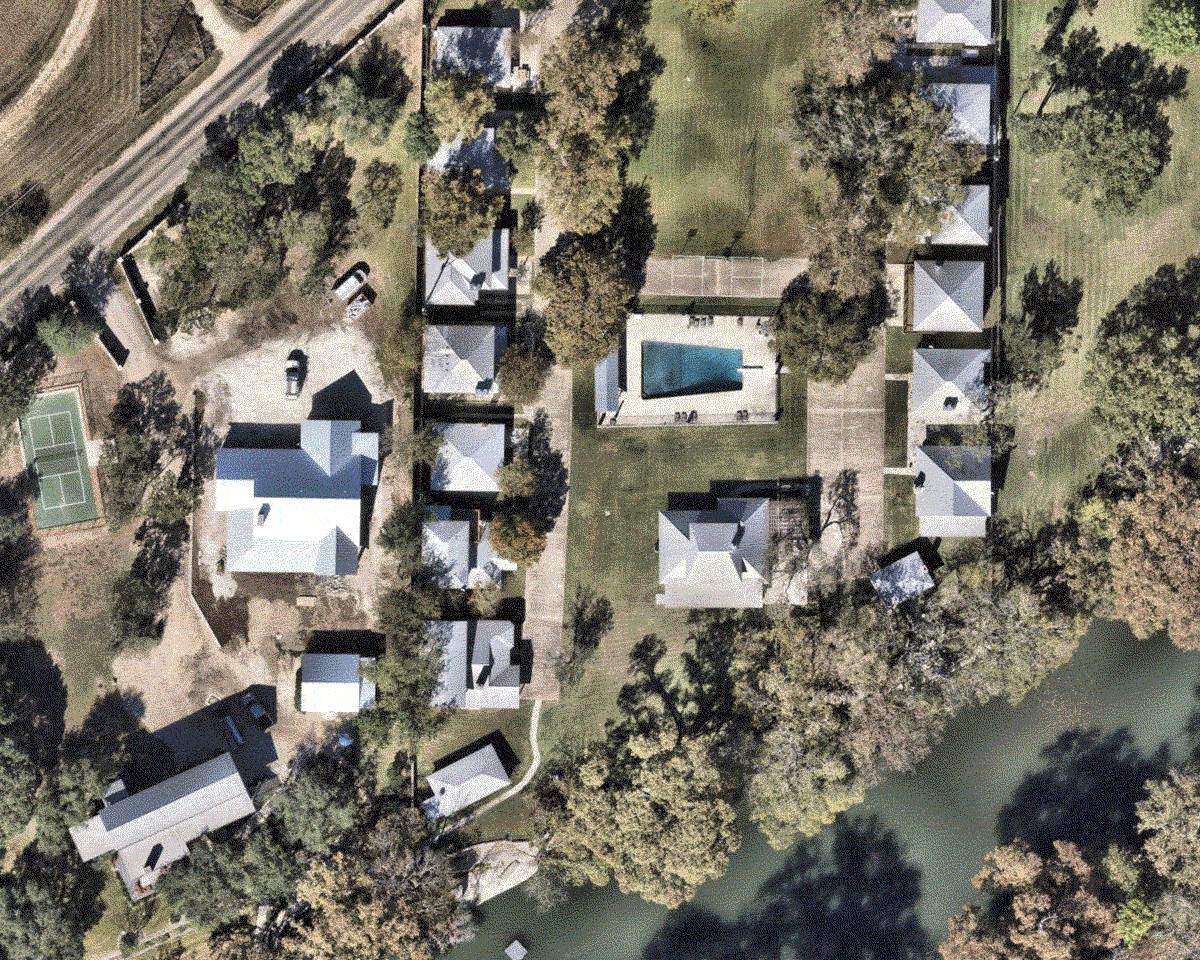
Photograph: Nearmap
Investigators of the catastrophic Hill Country flooding in Texas may never be able to pinpoint a precise moment that sealed the fate of 27 young girls, teenage counselors and staff who perished after a wall of water surged through Camp Mystic on the banks of the Guadalupe River.
But perhaps no bigger clue can be found than the account of an otherwise unremarkable and sparsely attended meeting of Kerr county commissioners in March 2018.
Members waited with anticipation for news of an application they submitted the previous year for a grant from the state of Texas to help pay for a comprehensive new flood warning system along the Guadalupe.
The county’s unreliable old network of gauges and sensors, installed following flooding in 1987 that killed 10 children trying to flee a waterside church camp, had been inactive since 1999. Commissioners were chasing a $1m slice of federal funding made newly available to the state after a succession of flood disasters, including Hurricane Harvey in August 2017.
Now-retired commissioner Tom Moser brought bad news, noting “about eight different counties” were selected, but “they didn’t select us,” according to minutes of the meeting still viewable online.
Tom Pollard, the county judge at the time, was incredulous.
“They prioritized us lower?” he asked, the county’s many low-lying and therefore vulnerable youth summer camps immediately adjacent to the Guadalupe uppermost in his mind.
“They did,” Moser replied solemnly.
Without that funding from the state, the project foundered. No widespread gauge system was ever set up that would have given early warning of a life-threatening torrent of water further up the river; no sirens ever installed that would have warned Camp Mystic residents that their lives were in peril and they needed to get out immediately.
The investigation will look at other missteps and lost opportunities along the way that might have brought a different outcome at the 99-year-old Christian-themed, all-girls camp that served as a joyous rite of passage for generations of young Texans.
Prominent among them will be this week’s revelation that the camp owner and director Dick Eastland, who lost his own life trying to ferry a group of his youngest campers to safety as the river rose towards a peak height of 37.5ft, waited more than an hour to issue an evacuation order after receiving a severe flood warning on his phone at 1.14am on 4 July.
Yet it is to the eternal regret of Moser, a former senior Nasa engineer who had studied flood monitoring and alert systems installed in other nearby counties, that money was never found or spent, either then or later, to replace or upgrade a broken mechanism born from a near-identical tragedy for the sole purpose of saving lives in the future.
“Not having the funds to accomplish it was not very satisfying to me but we tried,” Moser told NPR. “That’s all we could do. We didn’t have the resources in the county operating budget to do that.”
Moser, who did not return a message from the Guardian seeking further comment, had advocated for sirens, a proposal dropped from the state grant application when it became clear some residents and commissioners opposed them.
“If sirens were there, clearly people would have known about it. Would it have saved everybody? I don’t think so. This was an event that’s probably one chance in a million,” he told the radio network.
At Camp Mystic, like elsewhere in the county, residents were reliant on an outdated and patchwork early warning system of alerts. Some were from the National Weather Service (NWS), which Eastland’s family concedes he did receive. Other messages came from local authorities, some sent only after an inexplicable delay, which others along the Guadalupe’s banks say they did not see in any case.
Inside the camp, with water rising fast, especially around dormitories closest to the river where the youngest campers, mostly aged eight and nine, were sleeping, there was chaos. Many of the teenage counselors left in charge of the dormitories were left to make instant life-or-death decisions on their own, having lost contact with adult supervisors.
According to two counselors interviewed in the days following the disaster, campers were not allowed to bring mobile phones, and the counselors were made to surrender theirs, leaving them cut off from any emergency alerts.
Eastland, who had run the camp with his family since the 1980s and was a past director of the Upper Guadalupe River Authority that pressed for the original warning and alert system, was familiar with the danger of flash flooding from heavy rain.
“I’m sure there will be other drownings,” Eastland told the Austin American-Statesman in 1990, reported by CNN. “People don’t heed the warnings.”
In a Washington Post report that contained harrowing first-hand testimony from girls who were there, parents of some who were rescued from Camp Mystic said it was Eastland and his staff who ignored warnings on the morning of the disaster.
Also under scrutiny will be why Eastland made, and was granted, repeated applications to remove dozens of Camp Mystic buildings from the Federal Emergency Management Agency’s 100-year flood map, which allowed the camp to operate and expand in a known risk area.
A review by the Associated Press found that 15 of at least 30 exempted buildings were at the Camp Mystic Guadalupe site where most, if not all of the campers and counselors lost their lives.
Jeremy Porter, head of climate implications at First Street, a climate risk assessment and modelling company, said the dormitories were in a known flood zone, which records show had been swamped numerous times in the camp’s near century of existence.
“People that ran the camp had the ability to understand that the risk was close by, the risk was in the area, and maybe adapt the buildings. And there was no action there,” he said.
“In fact there were letters of map amendments that were submitted instead.”
But Porter said it was hard to place blame on any single person or entity: “A lot of that is just our overall risk psyche and understanding of what risk looks like, our expectation that these really rare events aren’t going to affect us and they’re not going to be as bad as we think they’re going to be.
“The way we treat climate risk and flood risk in the country is really that, you know, if it happens, it’ll be something we’ll be able to rebuild, recover, and then it won’t happen again for 100 years.”
The Guardian was unable to reach anybody at Camp Mystic for comment.
Donna Gable Hatch, a writer and former staff editor at the Kerrville Daily Times, said she believed lives would have been saved at Camp Mystic with an early warning system, but city and county officials were not responsible for its absence.
“If the funds had been made available in a timely and adequate manner, this catastrophe might have unfolded differently. But too often, those at the helm of small towns must wait for permission, wait for funding, wait for bureaucracy to catch up to reality,” she wrote in a guest editorial for her former employer.
“To accuse local leaders of negligence is to completely misunderstand who they are and what this place means. In Kerr county, heartbreak isn’t abstract. It has a name. A face. It’s a neighbor, a classmate, a church member or a childhood friend.
“The truth will come out. In time, we’ll trace the chain of failure back to where it truly began – not in Kerrville, but in the halls of distant agencies who failed to act with the urgency that rural lives deserved.”







